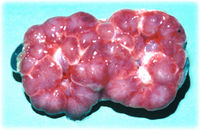Difference between revisions of "Lizard and Snake Immune System"
| Line 1: | Line 1: | ||
| − | {{ | + | {{review}} |
[[Image:Boa_spleen_crop.jpg|200px|thumb|right|'''Boa constrictor spleen''' (Copyright © RVC)]] | [[Image:Boa_spleen_crop.jpg|200px|thumb|right|'''Boa constrictor spleen''' (Copyright © RVC)]] | ||
The immune system of lizards and snakes is influenced by age, nutrition, general health, ambient temperature and season. In temperate species thymic involution and splenic follicle regression occur seasonally. Antibody production is temperature dependent. The immune system functions most efficiently within a reptile's [[Preferred optimum temperature zone|preferred optimum temperature zone (POTZ)]] although at a low level in comparison to birds and mammals. In captivity, lizards and snakes that are kept below their [[Preferred optimum temperature zone|POTZ]] are immunocompromised and are therefore predisposed to infection with opportunistic pathogens. | The immune system of lizards and snakes is influenced by age, nutrition, general health, ambient temperature and season. In temperate species thymic involution and splenic follicle regression occur seasonally. Antibody production is temperature dependent. The immune system functions most efficiently within a reptile's [[Preferred optimum temperature zone|preferred optimum temperature zone (POTZ)]] although at a low level in comparison to birds and mammals. In captivity, lizards and snakes that are kept below their [[Preferred optimum temperature zone|POTZ]] are immunocompromised and are therefore predisposed to infection with opportunistic pathogens. | ||
| Line 6: | Line 6: | ||
* '''Find out more about [[:Category:Snake Diseases|snake diseases]]'''. | * '''Find out more about [[:Category:Snake Diseases|snake diseases]]'''. | ||
| + | ==Literature Search== | ||
| + | [[File:CABI logo.jpg|left|90px]] | ||
| − | |||
| − | |||
| − | |||
| + | Use these links to find recent scientific publications via CAB Abstracts (log in required unless accessing from a subscribing organisation). | ||
| + | <br><br><br> | ||
| + | [http://www.cabi.org/cabdirect/FullTextPDF/2009/20093118394.pdf '''Clinical reptile immunology: antibodies to blood cells.''' Mitchell, M. A.; The North American Veterinary Conference, Gainesville, USA, Small animal and exotics. Proceedings of the North American Veterinary Conference, Orlando, Florida, USA, 17-21 January, 2009, 2009, pp 1788, 5 ref. - '''Full Text Article'''] | ||
| − | |||
| − | |||
| − | |||
[[Category:Lizard_Physiology]] | [[Category:Lizard_Physiology]] | ||
[[Category:Snake Physiology]] | [[Category:Snake Physiology]] | ||
Revision as of 10:02, 2 November 2010
| This article has been peer reviewed but is awaiting expert review. If you would like to help with this, please see more information about expert reviewing. |
The immune system of lizards and snakes is influenced by age, nutrition, general health, ambient temperature and season. In temperate species thymic involution and splenic follicle regression occur seasonally. Antibody production is temperature dependent. The immune system functions most efficiently within a reptile's preferred optimum temperature zone (POTZ) although at a low level in comparison to birds and mammals. In captivity, lizards and snakes that are kept below their POTZ are immunocompromised and are therefore predisposed to infection with opportunistic pathogens.
- Find out more about lizard diseases.
- Find out more about snake diseases.
Literature Search
Use these links to find recent scientific publications via CAB Abstracts (log in required unless accessing from a subscribing organisation).
Clinical reptile immunology: antibodies to blood cells. Mitchell, M. A.; The North American Veterinary Conference, Gainesville, USA, Small animal and exotics. Proceedings of the North American Veterinary Conference, Orlando, Florida, USA, 17-21 January, 2009, 2009, pp 1788, 5 ref. - Full Text Article

